This post may contain affiliate links. Please see our disclosure policy.
Canning chicken pot pie filling is an easy way to put up a delicious meal in a jar right on your pantry shelf. This hearty chicken stew can be served as is, baked into a pie shell or topped with biscuits for a filling meal in no time.
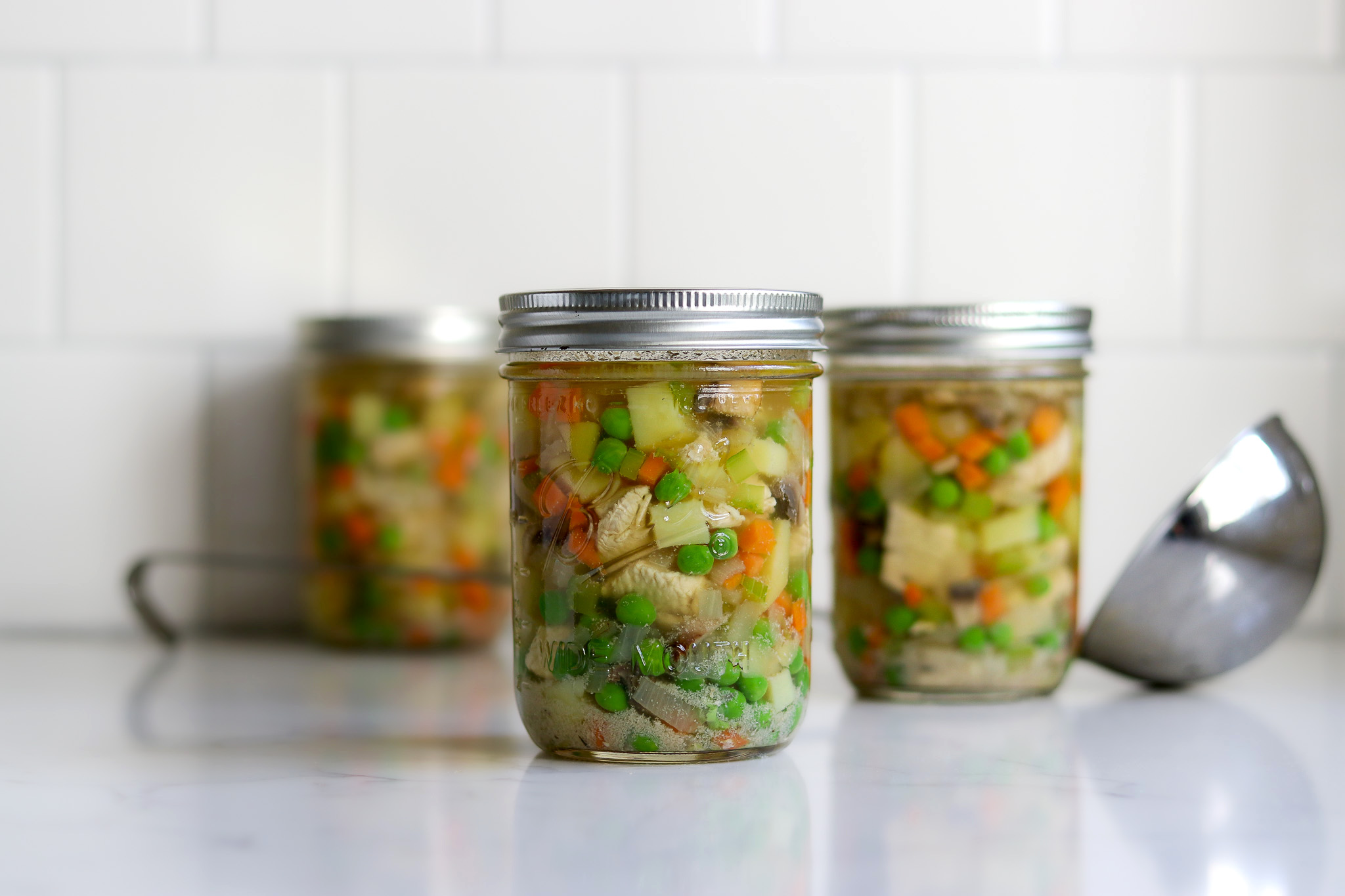
Chicken pot pie is an amazing dish you can easily prepare at home, but it takes some time to whip one up.
If you’re unfamiliar with this hearty classic, chicken pot pie is made of shredded chicken, vegetables, and a rich broth, all combined in a savory dough.
Canning this meal lets you enjoy it even more, as the canning process preserves these flavors to create a delicious gourmet treat that can be prepared at any time.
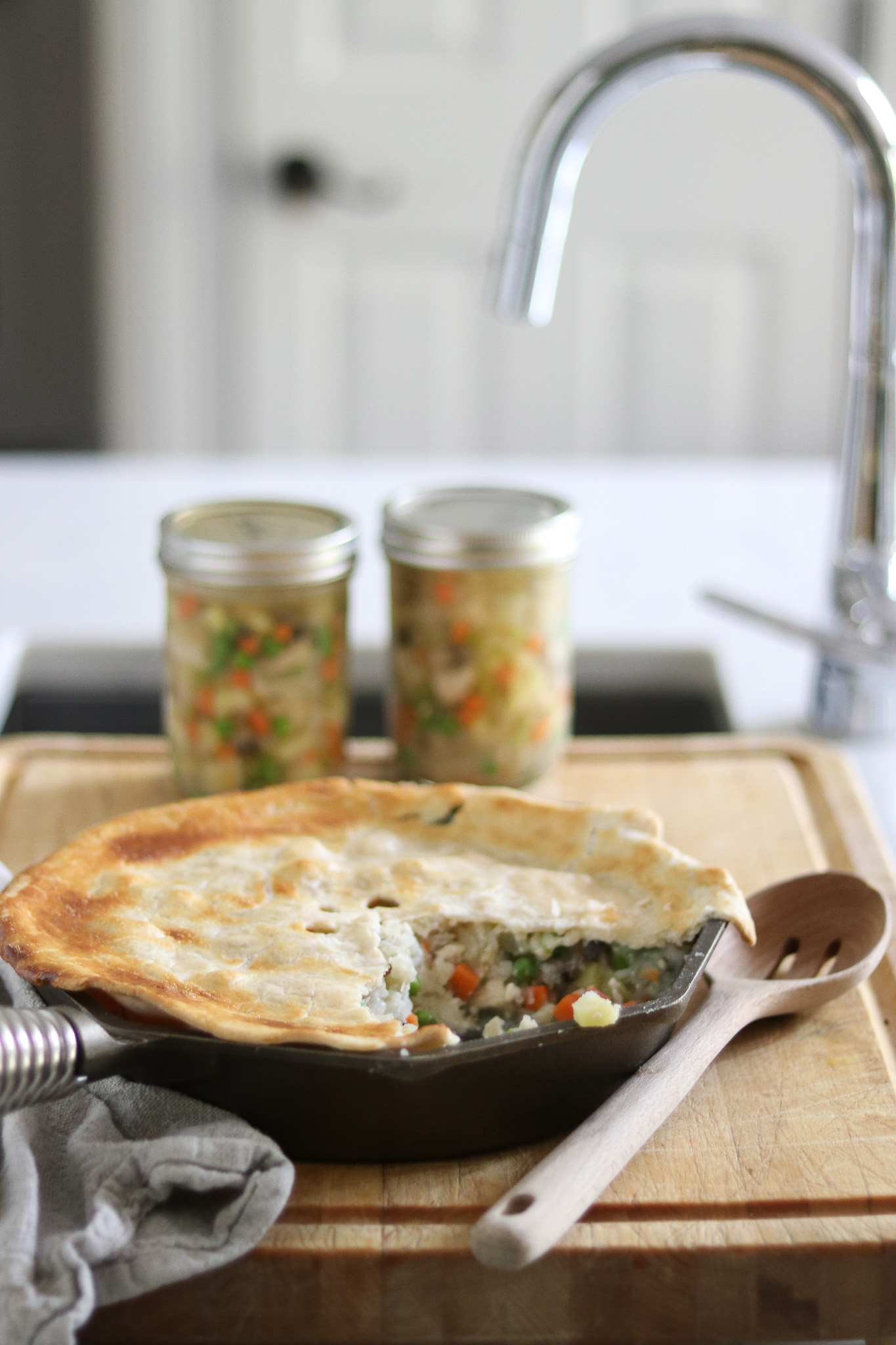
With a little planning ahead, you can have jars of home-canned chicken pot pie filling on your shelf so that anytime you’re craving something hearty and tasty, your homemade canned filling will be ready at a moment’s notice.
Although canning may seem intimidating at first, it’s actually quite easy. It will give you the comfort of knowing exactly where your food comes from – plus maximum convenience and more deliciousness than you know what to do with.
Since it contains both meat and vegetables, this is a pressure canning recipe. If you’re unfamiliar with pressure canning, I’d suggest reading my beginner’s guide to pressure canning before beginning.

Ingredients for Chicken Pot Pie Filling
The ingredients for canning chicken pot pie filling are quite simple.
The beauty of this recipe is that it’s possible to customize it by adding different spices, herbs, and even vegetables (within reason – more on this below).
This recipe comes from The Ball All New Book of Canning and Preserving (pg. 283). I love that book, and it has so many delicious canning recipes, both pressure canning and water bath canning.
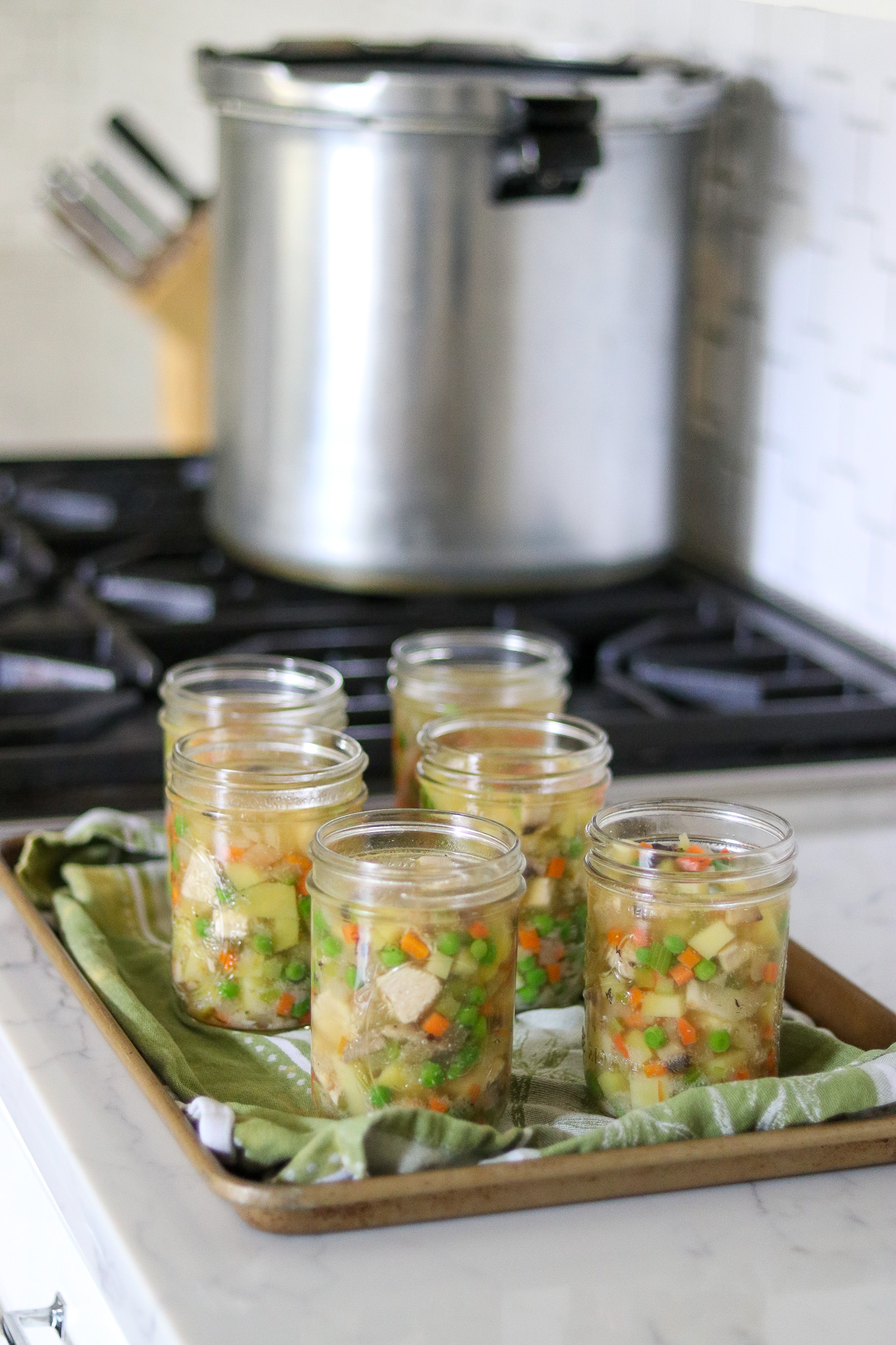
To make a canner batch of 6 pints (1 pint or 500 ml each) jars, you’ll need the following:
- 3 cups (750 ml) skinned and boned raw chicken, cut into 1-inch (2.5 cm) cubes
- 1 ½ cups (375 ml) diced onion (about 2 medium onions)
- ½ cup (125 ml) diced fresh mushrooms
- 1 ½ cups (375 ml) diced carrots (roughly 3 medium carrots)
- 1 cup (250 ml) diced Yukon gold potatoes
- ½ cup (125 ml) baby sweet peas
- ½ cup (125 ml) diced celery
- 5 cups (1.25 liters) chicken stock or bone broth
- 3 tbsp (45 ml) butter
- 1 cup (250 ml) dry white wine
- 1 tsp (5 ml) dried thyme
- 1 tsp (5 ml) salt
- ½ tsp (2 ml) black pepper
- 1 bay leaf
- 1 tbsp (15 ml) bottled lemon juice
The lemon juice in this recipe is added for flavor, as is the white wine. Both increase the acidity of the broth, which enhances the flavor of the vegetables. They’re not strictly required for safe canning, as this is a pressure canning recipe. You can use water in place of those ingredients if you choose, but I do think it’s better as it is.
As to the dry spices (thyme and black pepper), you can increase or decrease those as you see fit. You can also add in other dry spices that suit your tastes.
Do not increase the total quantity of vegetables, but you can omit some if they’re not to your family’s tastes. If you don’t like mushrooms, you can skip them.
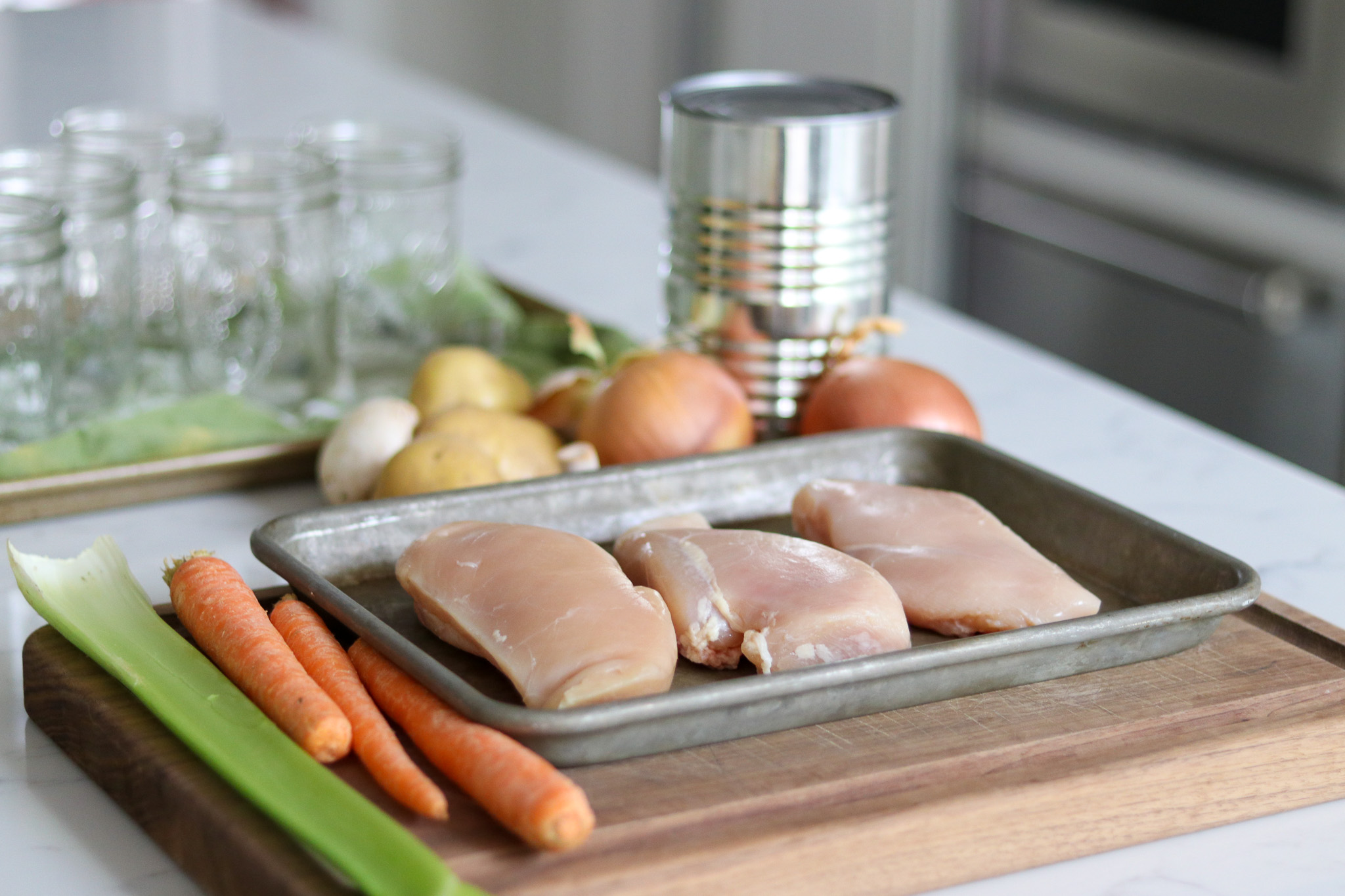
You can swap out some of the vegetables if you choose, but make sure you maintain the same ratios of vegetables to other ingredients for canning safety.
You want to make sure that the jars are loosely packed, so have a kettle of water (or extra broth on hand) to top the jars with more liquid if you run short.
This recipe from Ball Canning is well-measured though, and it should fill the jars just right.
(If you omit something, you may need extra water to make up the space difference in the jars.)
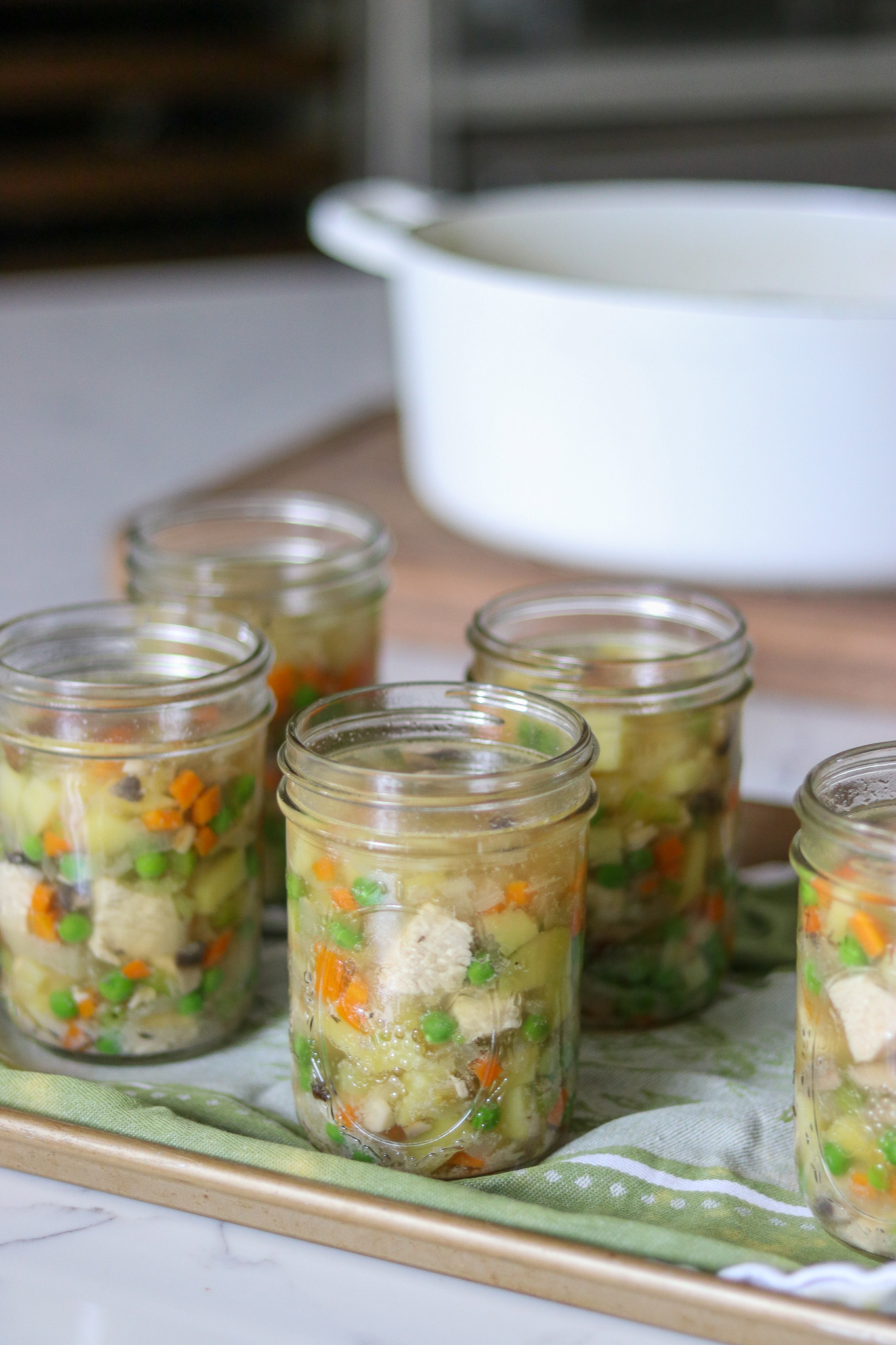
Any cut of chicken may be used, but chicken breast tends to offer the most flavor and the best texture. Chicken thighs also work really well, and have a slightly richer flavor.
Commercial canned or boxed chicken broth or stock may be used in this recipe, or you can use homemade chicken broth if you have it on hand. Vegetable broths or other types of broths will also work.
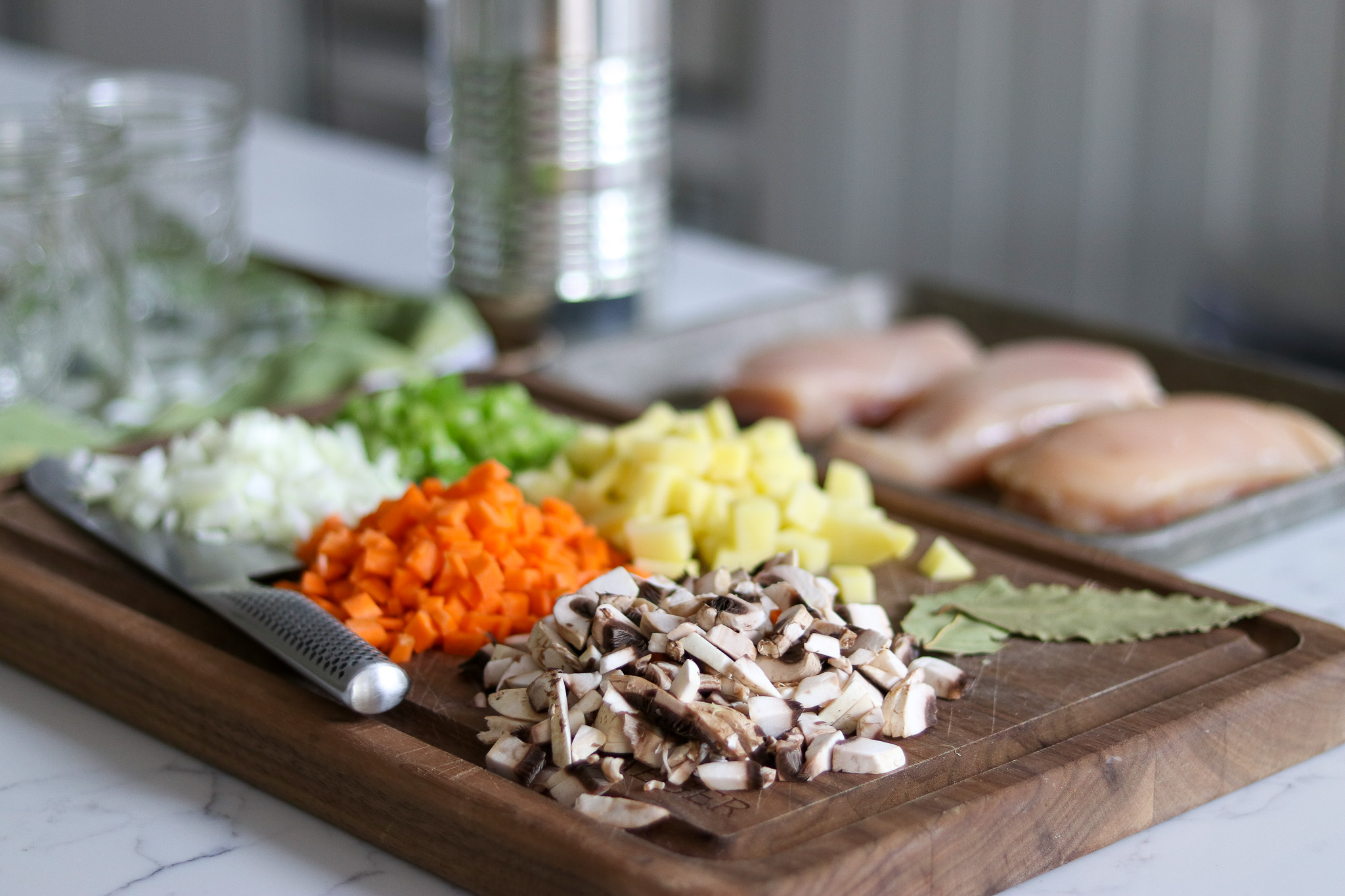
As with any pressure canning recipe, the vegetables must be peeled before canning.
This helps with the quality of the finished dish, as the peels tend to fall off and toughen during canning. But, more importantly, it also removes the outer layer of root vegetables, which have the highest concentration of potentially problematic bacteria.
Potatoes and carrots are always peeled for pressure-canning recipes.
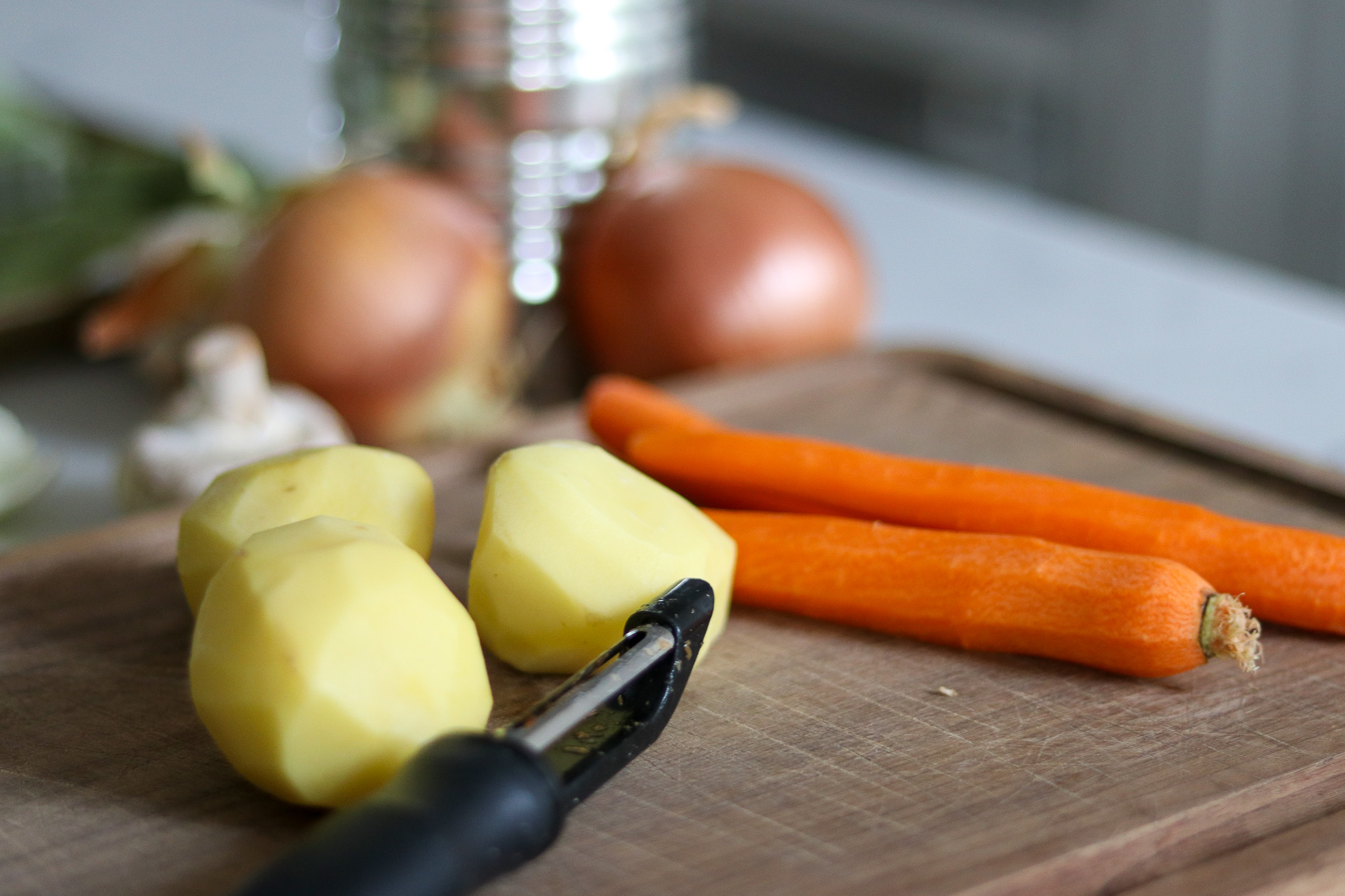
Canning Chicken Pot Pie Filling
Start by chopping the vegetables.
You can use whatever shape you’d like, but aim for uniform-sized pieces so everything cooks evenly.
Personally, I think a medium dice of cubes makes for the best-finished presentation.
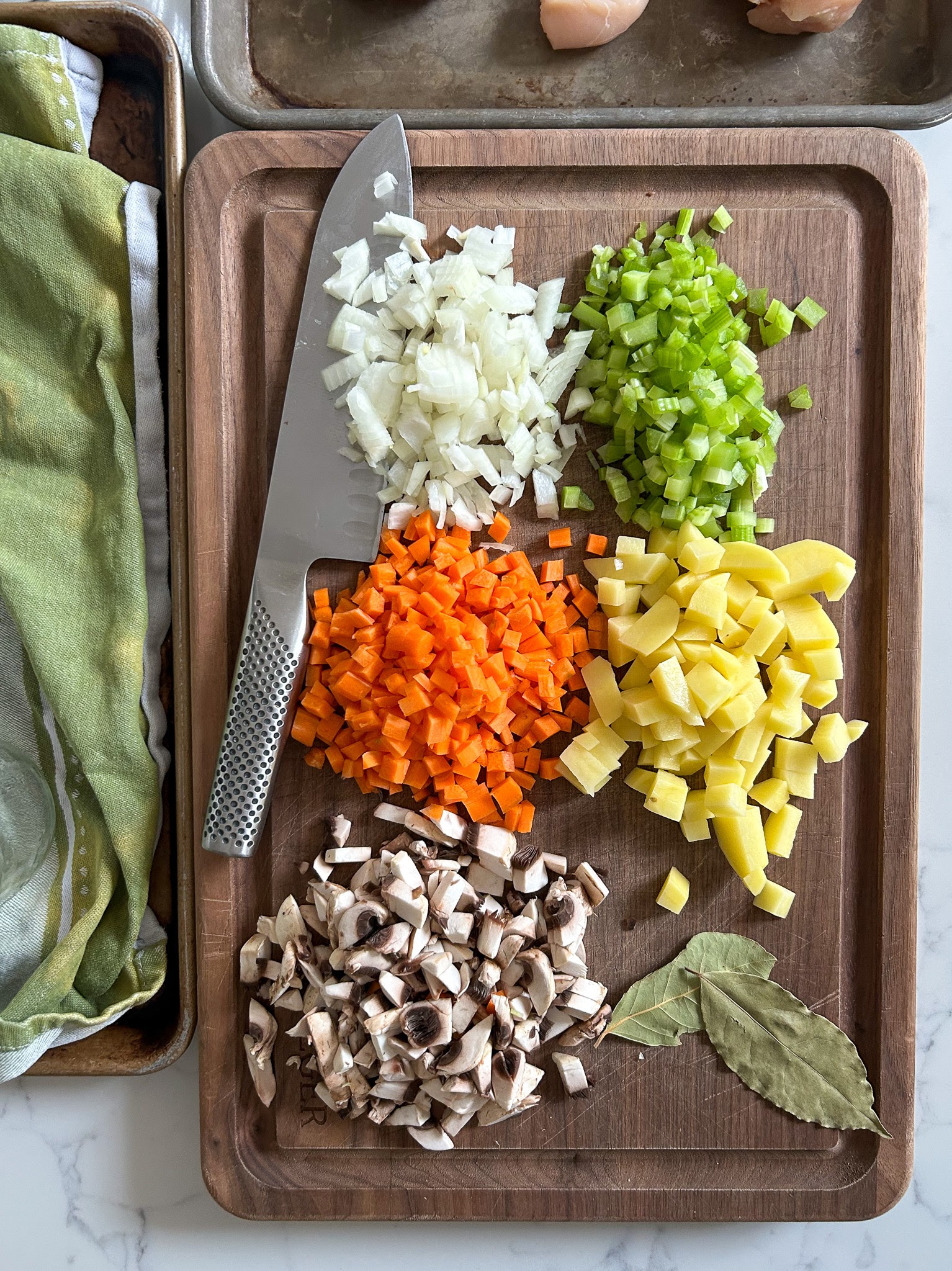
Next, assemble the rest of your prepared ingredients.
This includes diced boneless chicken, white wine, and broth, along with spices.
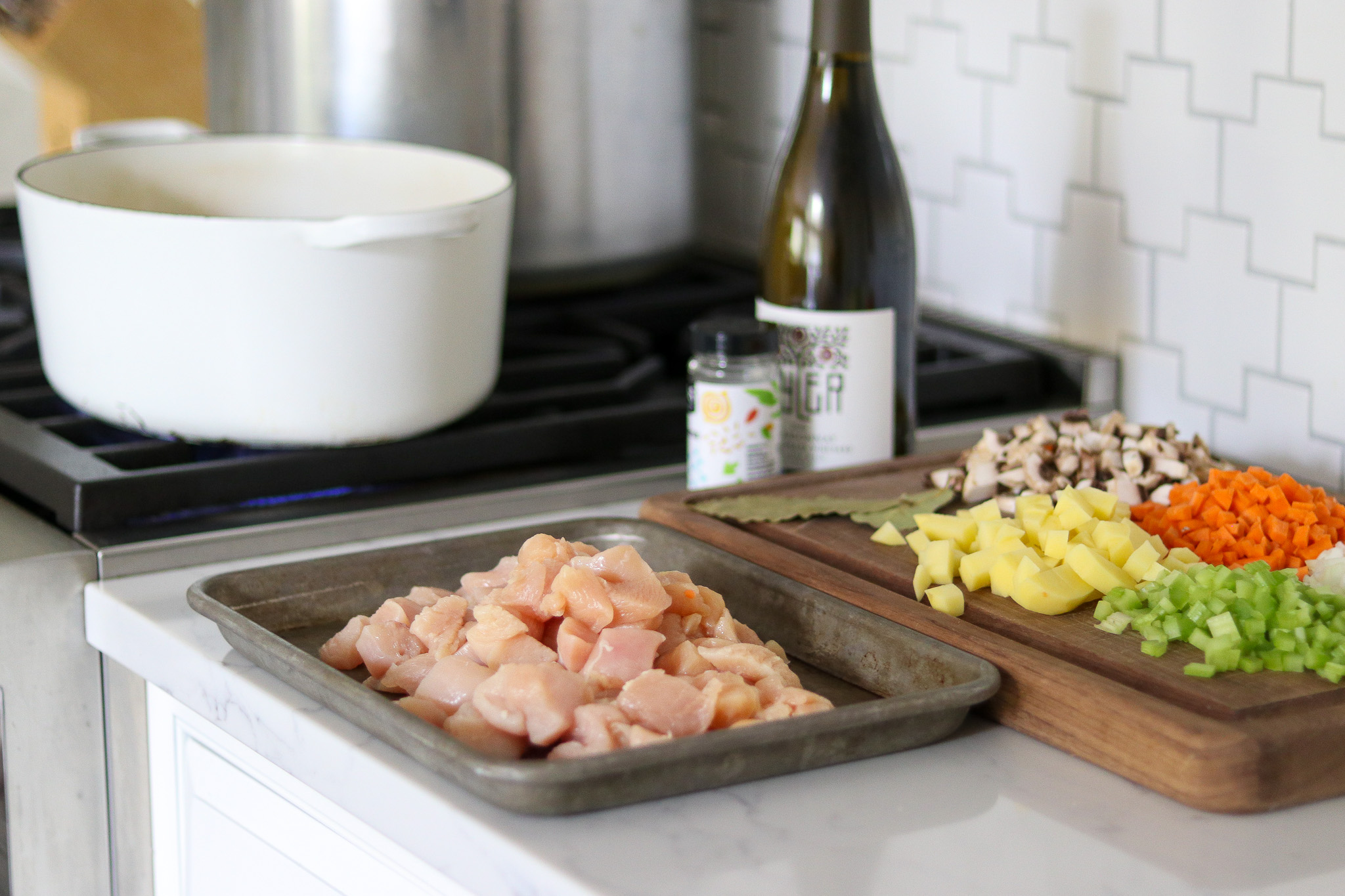
Melt the butter in a Dutch oven or saucepan over medium heat.
Add the mushrooms and onions, then saute until the mushrooms are lightly browned (about three minutes).
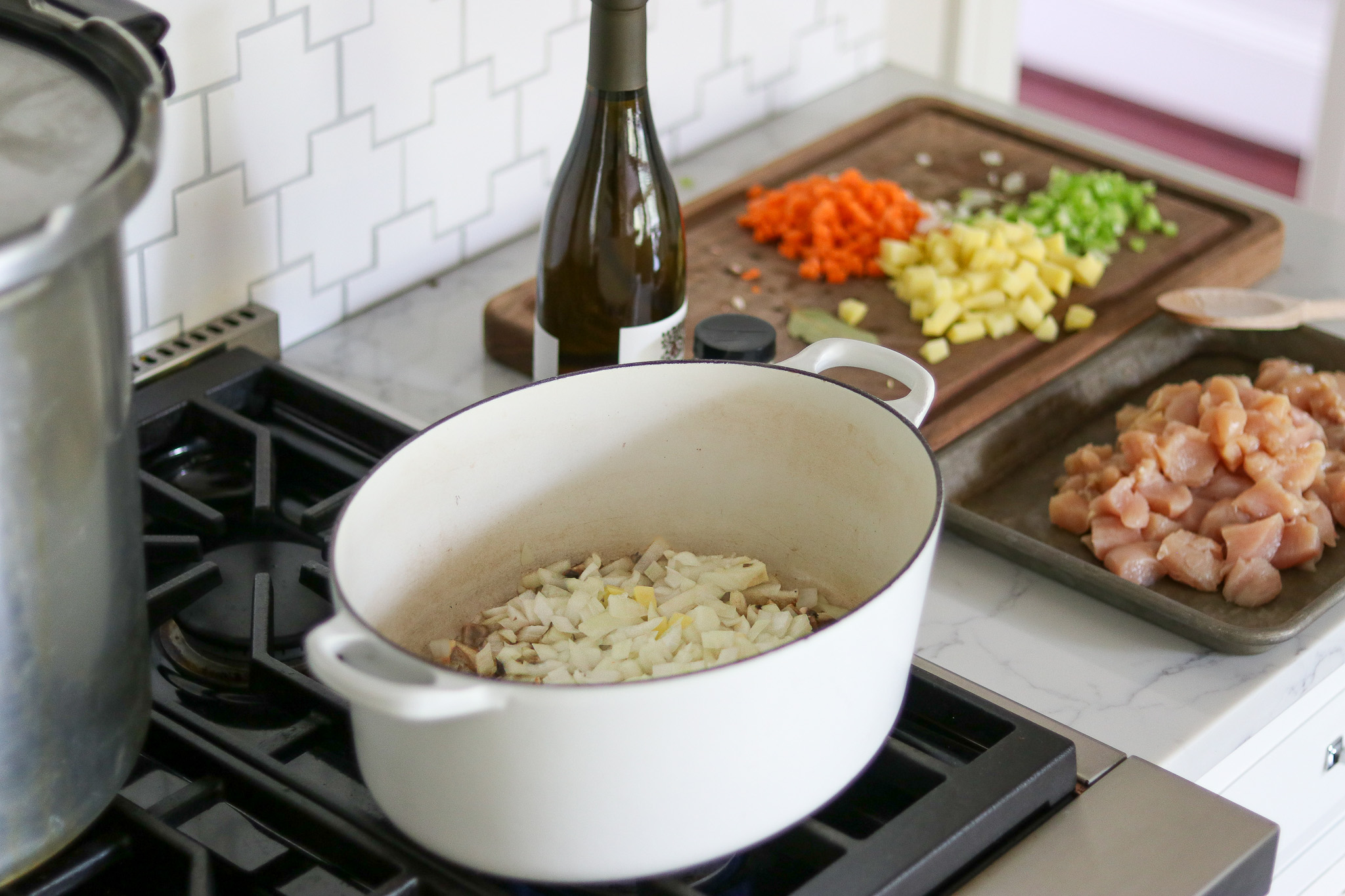
Add the chicken, carrots, potatoes, and celery, again, sauteeing until golden brown, or for about five minutes.
Stir in the stock, and then add the white wine, thyme, salt, pepper, and bay leaf.
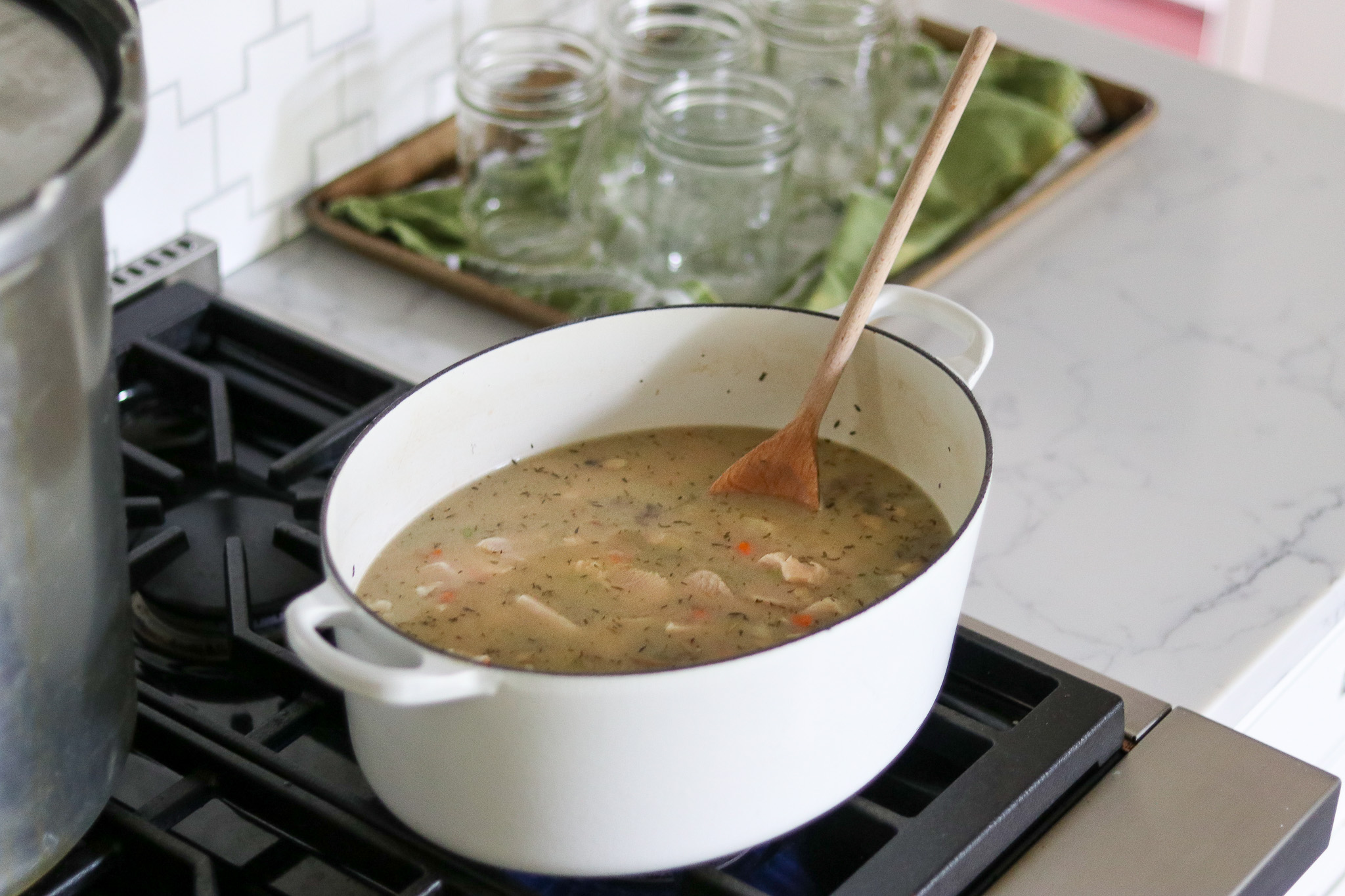
Bring to a boil, then reduce heat to medium and cook uncovered for about 10 minutes, or until the vegetables are tender and the chicken is cooked through. Stir occasionally. Once the chicken is cooked through, remove the bay leaf and take the pan off the heat.
Finally, once off the heat, stir in the peas and lemon juice.
Ladle the mixture into hot jars, leaving 1″ (2.5 centimeters) of headspace.
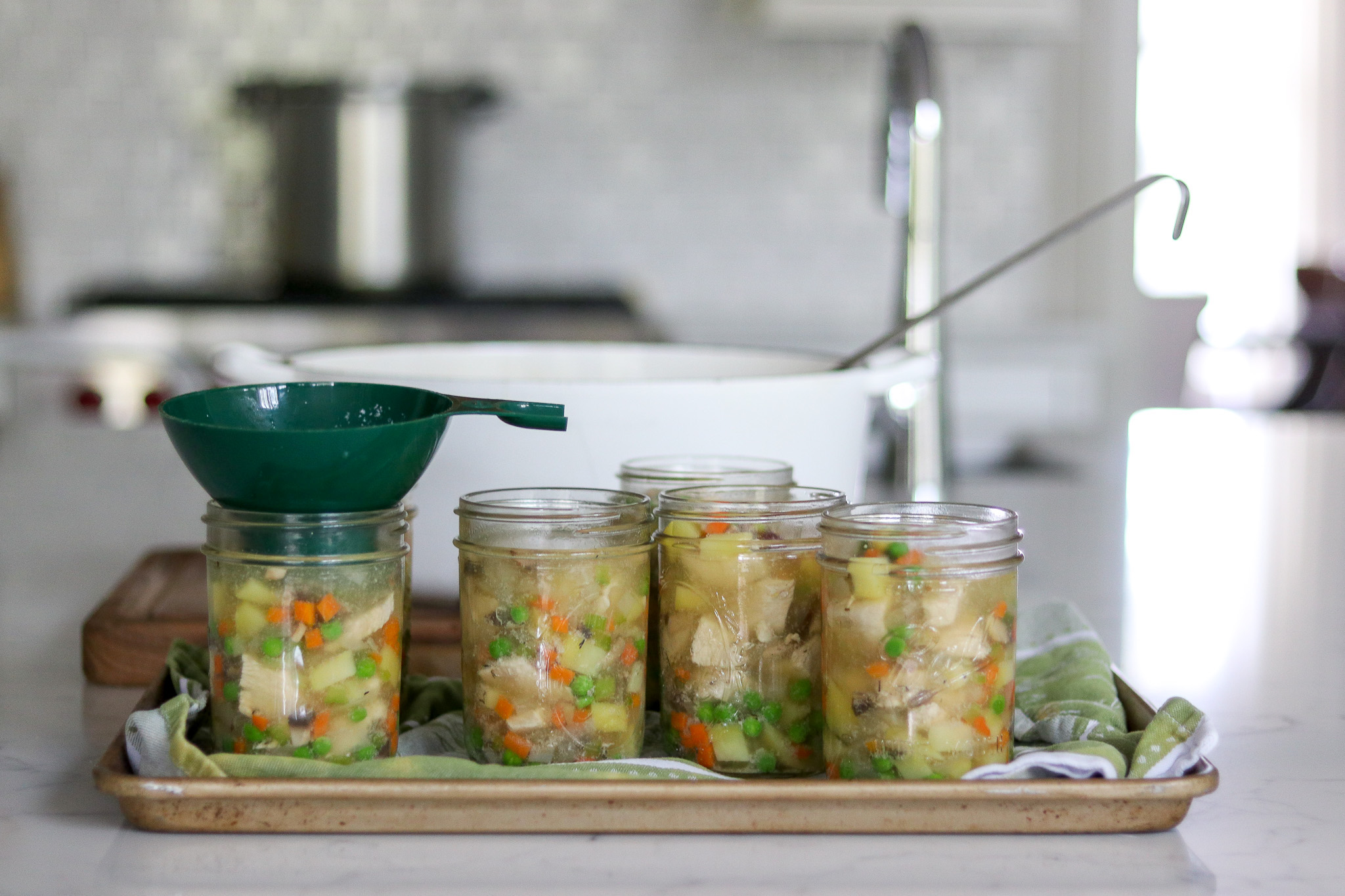
Use the air bubble tool to remove any bubbles, then make sure adequate headspace remains.
Sometimes debubbling jars lowers the level inside the jar substantially. Adjust headspace if necessary to maintain 1” from the rim.
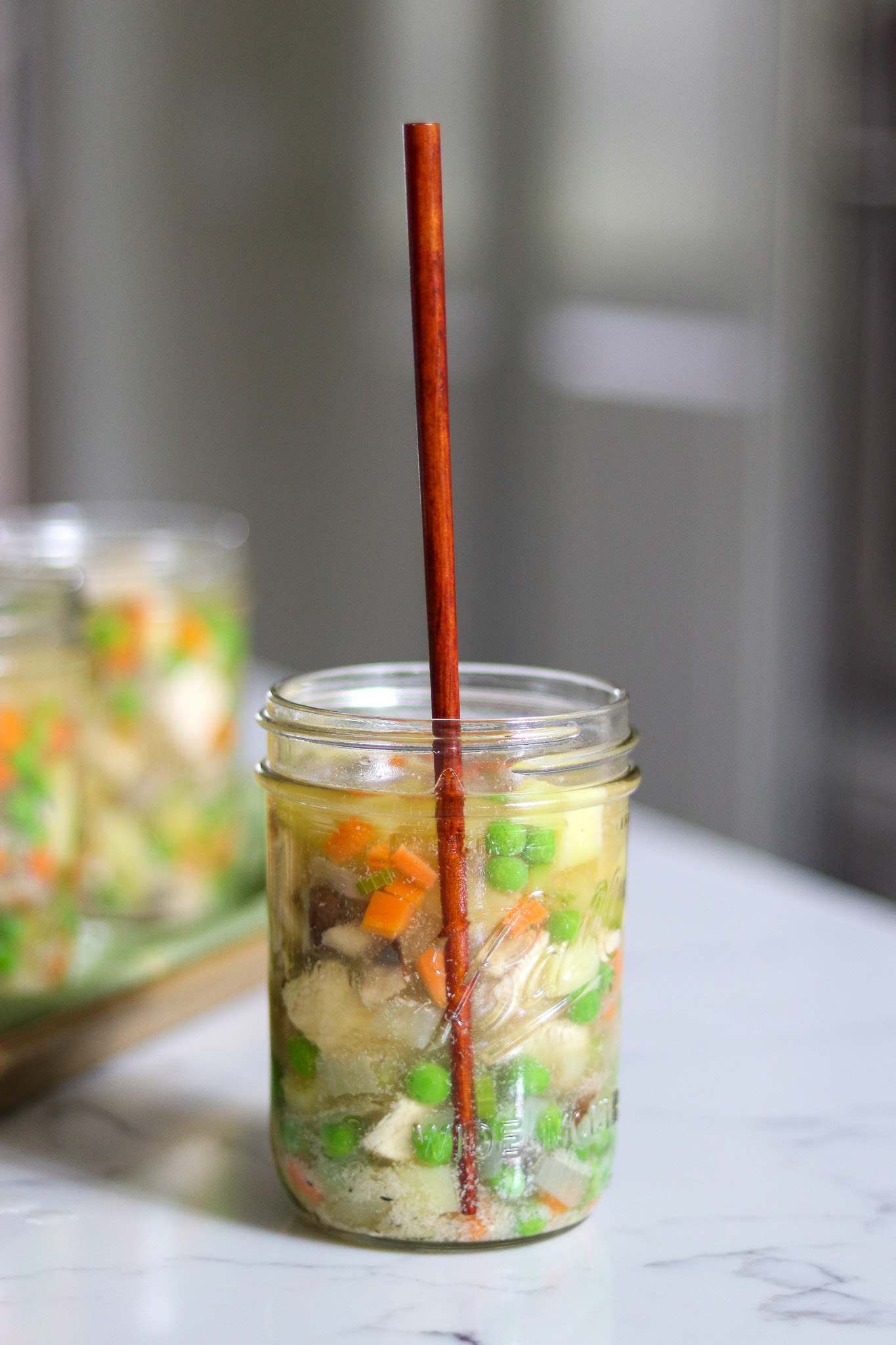
Wipe the rims of the jars to remove any food particles.
Apply the bands and lids, then adjust to fingertip tight.
Repeat until all jars are filled, then load each jar into your canner.
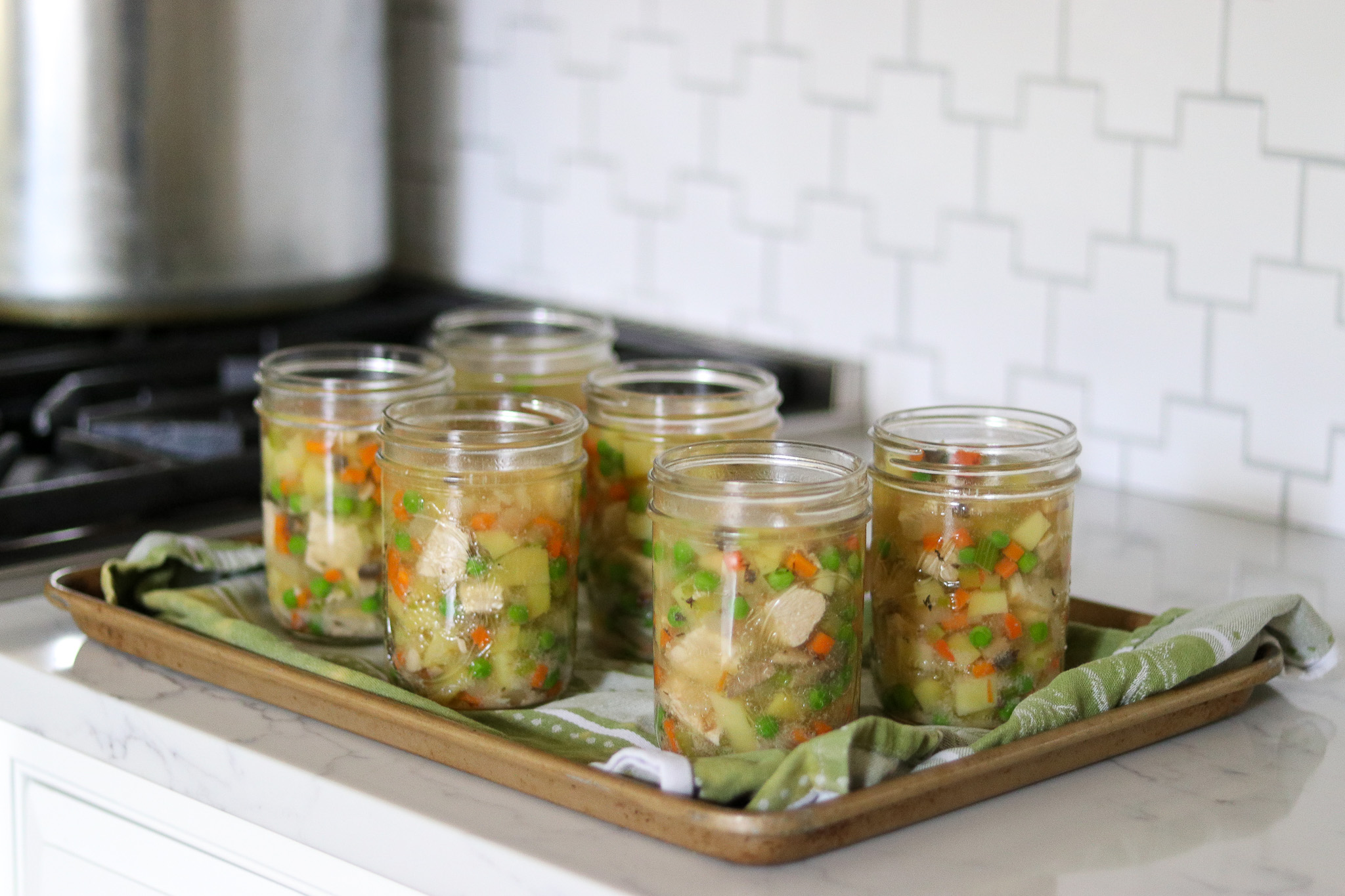
Put the lid on the canner and turn to the locked position, but do not seal the canner yet.
Adjust the heat to medium-high and allow the steam to vent for 10 minutes.
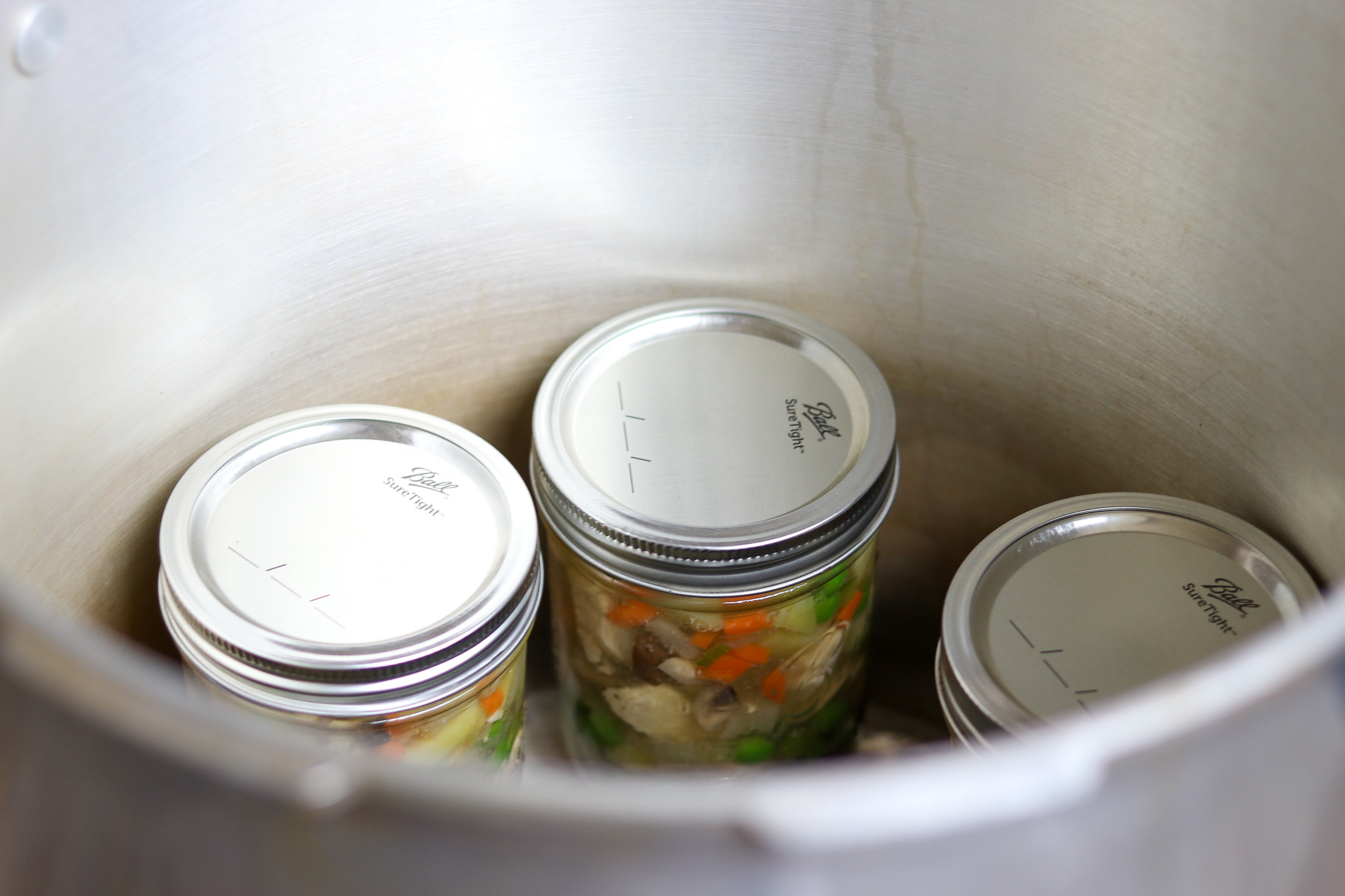
Put the counterweight or weighted gauge on the vent (depending on the manufacturer’s instructions), then bring the pressure to 10 lbs for a weighted-gauge canner or 11 lbs pressure for a dial-gauge canner. Be sure to adjust pressure for altitude if you’re above 1,000 feet in elevation (altitude adjustments below).
Process pint jars for 75 minutes and quart jars for 90 minutes.
When the time has finished, turn off the heat, then allow the canner to return on its own to zero pressure.
Let the canner sit for five more minutes before removing the lid. Cool the jars in the canner for another 10 minutes, then use a jar lifter to remove them from the canner.
Allow the jars to cool on the counter for 12 hours. Check the seals, and store any unsealed jars in the refrigerator for immediate use.
Properly canned and sealed jars will maintain peak quality on the pantry shelf for 12 to 18 months.
Refrigerate after opening.
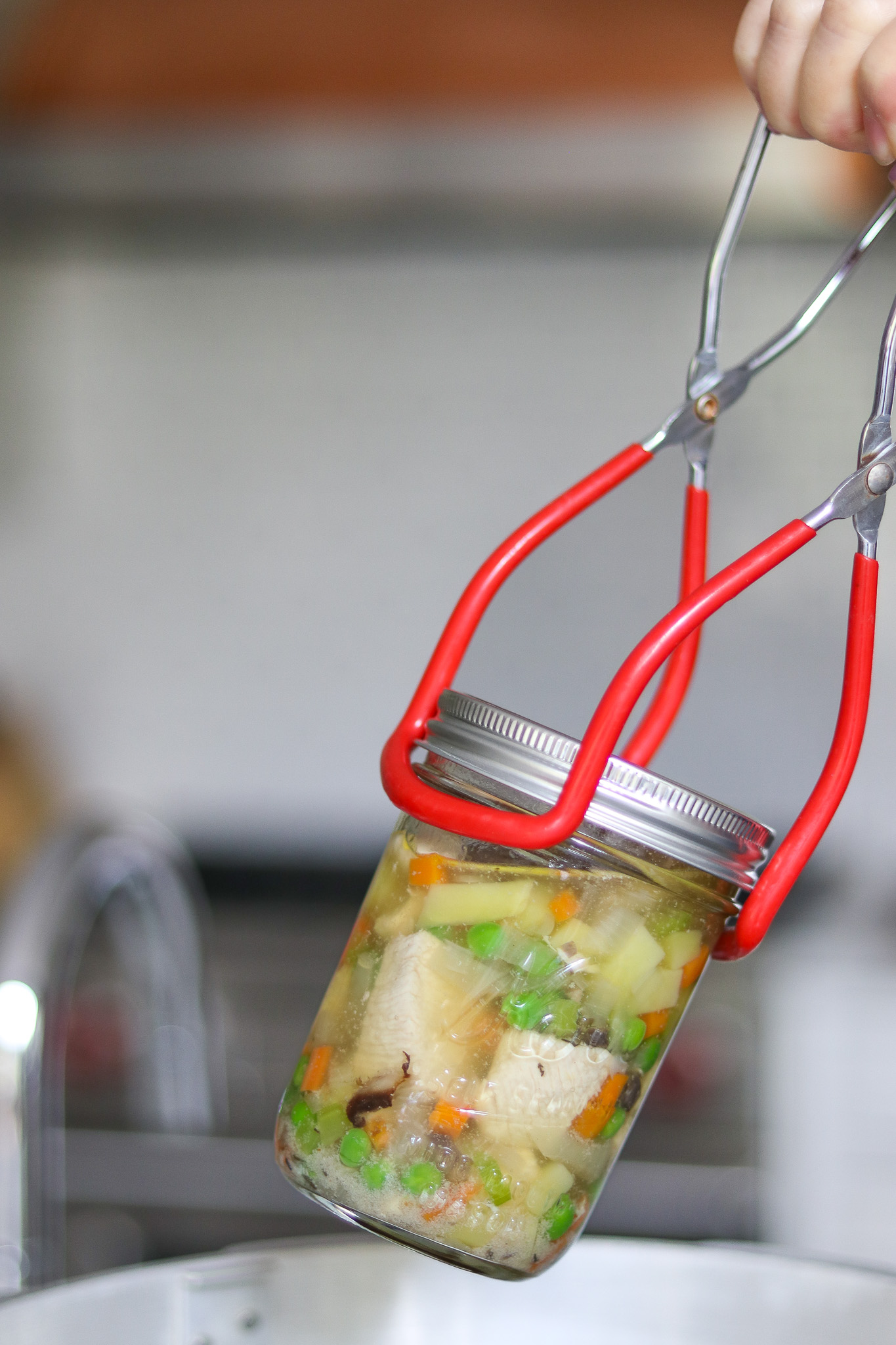
Altitude Adjustments
Canning time remains the same regardless of altitude. However, the processing pressure increases as altitude increases.
Use the following table to determine the correct processing pressure if you’re above 1,000 feet in elevation.
For dial gauge pressure canners:
- 0 to 2,000 feet in elevation – 11 lbs pressure
- 2,001 to 4,000 feet in elevation – 12 lbs pressure
- 4,001 to 6,000 feet in elevation – 13 lbs pressure
- 6,001 to 8,000 feet in elevation – 14 lbs pressure
For weighted gauge pressure canners:
- Above 1,000 feet – 15 lbs pressure
- 0 to 1,000 feet in elevation – 10 lbs pressure
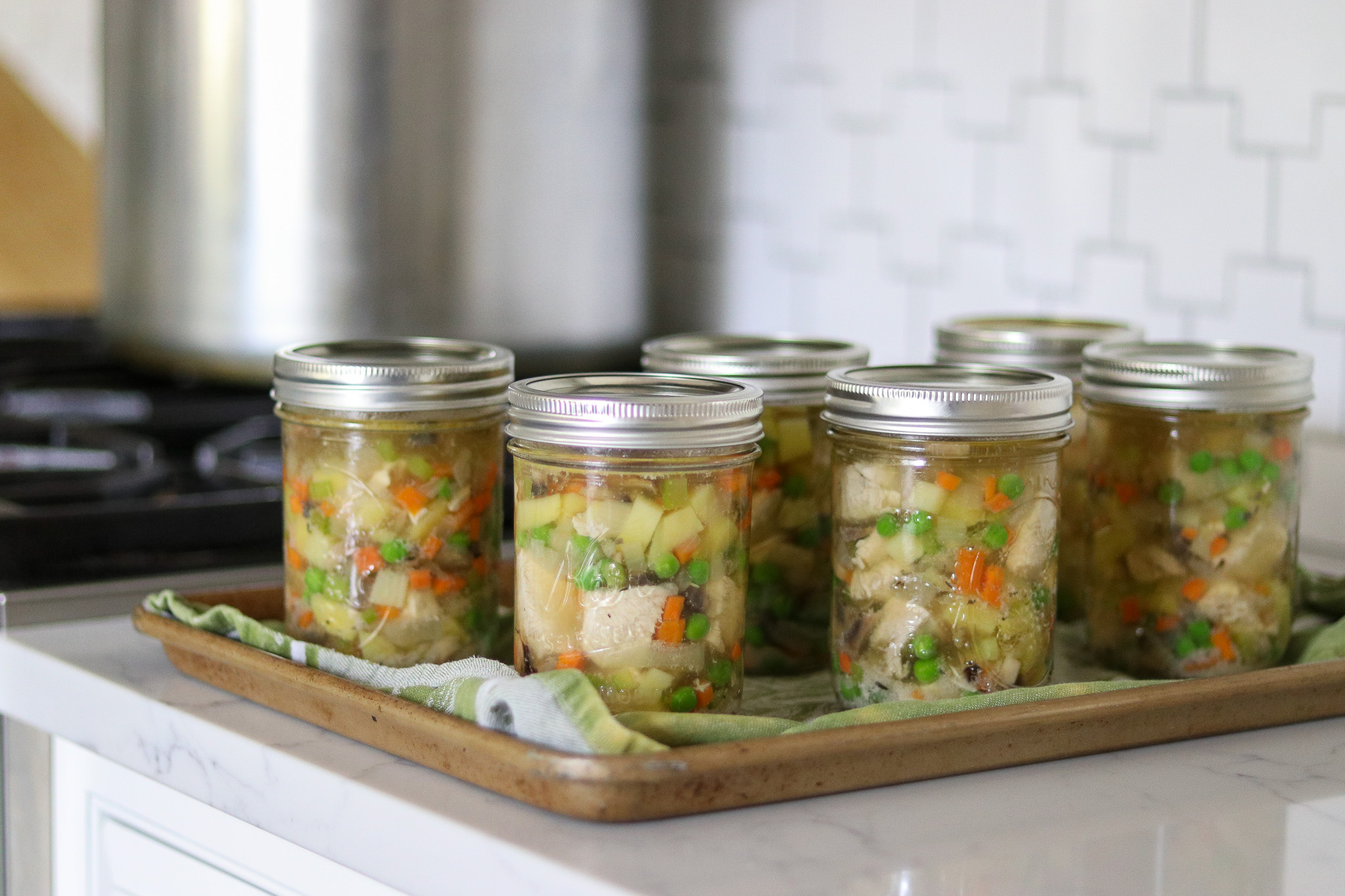
Serving Chicken Pot Pie Filling
The serving options for this recipe are endless!
It tastes great by itself, as a stew, making it ideal for a hearty soup and sandwich (or soup and salad) lunch.
It also can serve as the base for a hearty and rich chicken pot pie.
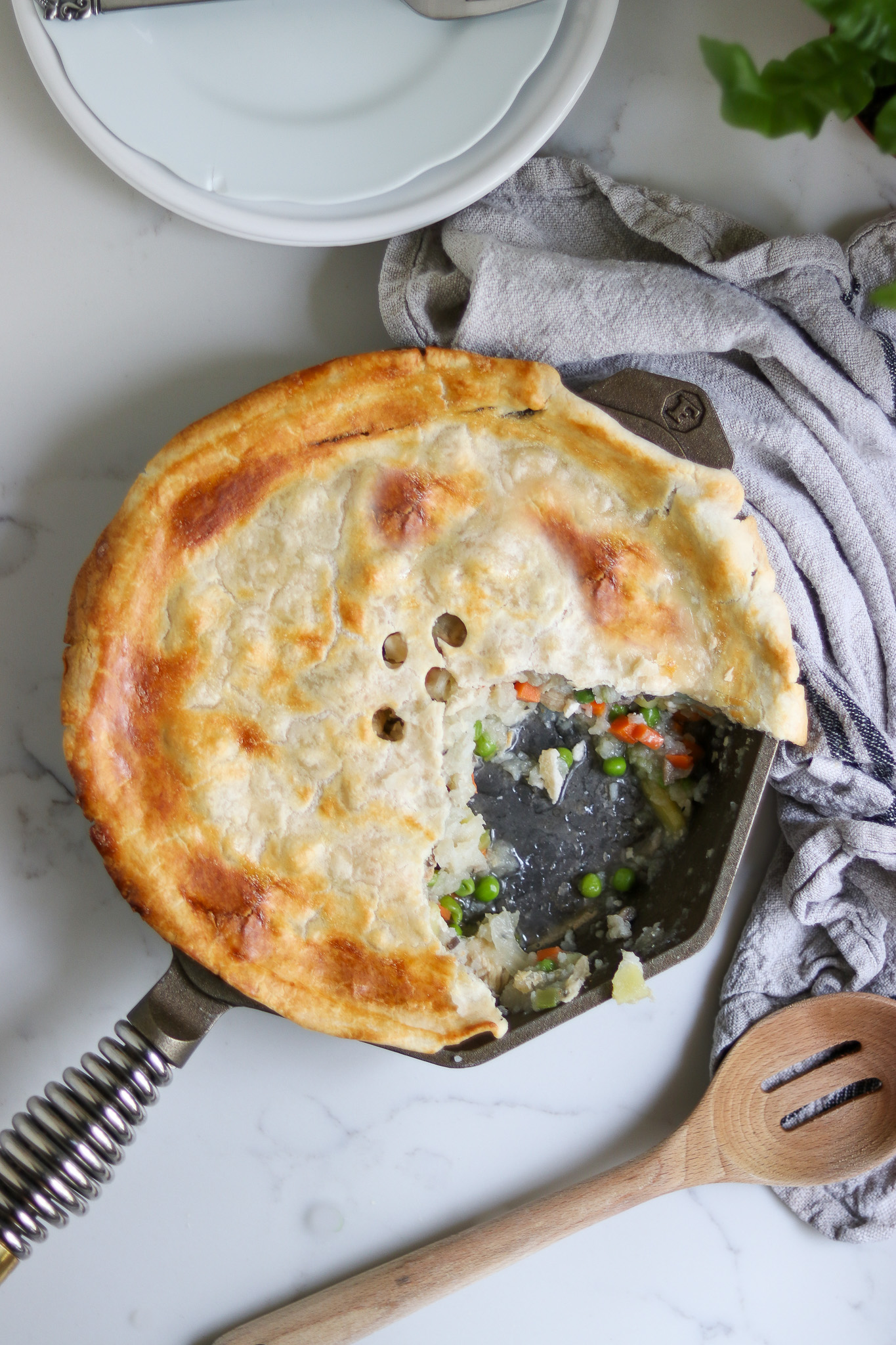
To serve it as a soup, simply reheat it upon opening the jars, either on the stovetop or in the microwave.
If you’d like to enjoy it as a chicken pot pie, preheat the oven to 400 degrees Fahrenheit (200 degrees Celsius).
Strain the broth from the jars, reserving some of the broth off to the side. Melt two tablespoons of butter in a skillet over medium heat, stirring in two tablespoons (30 ml) of flour as a thickener.
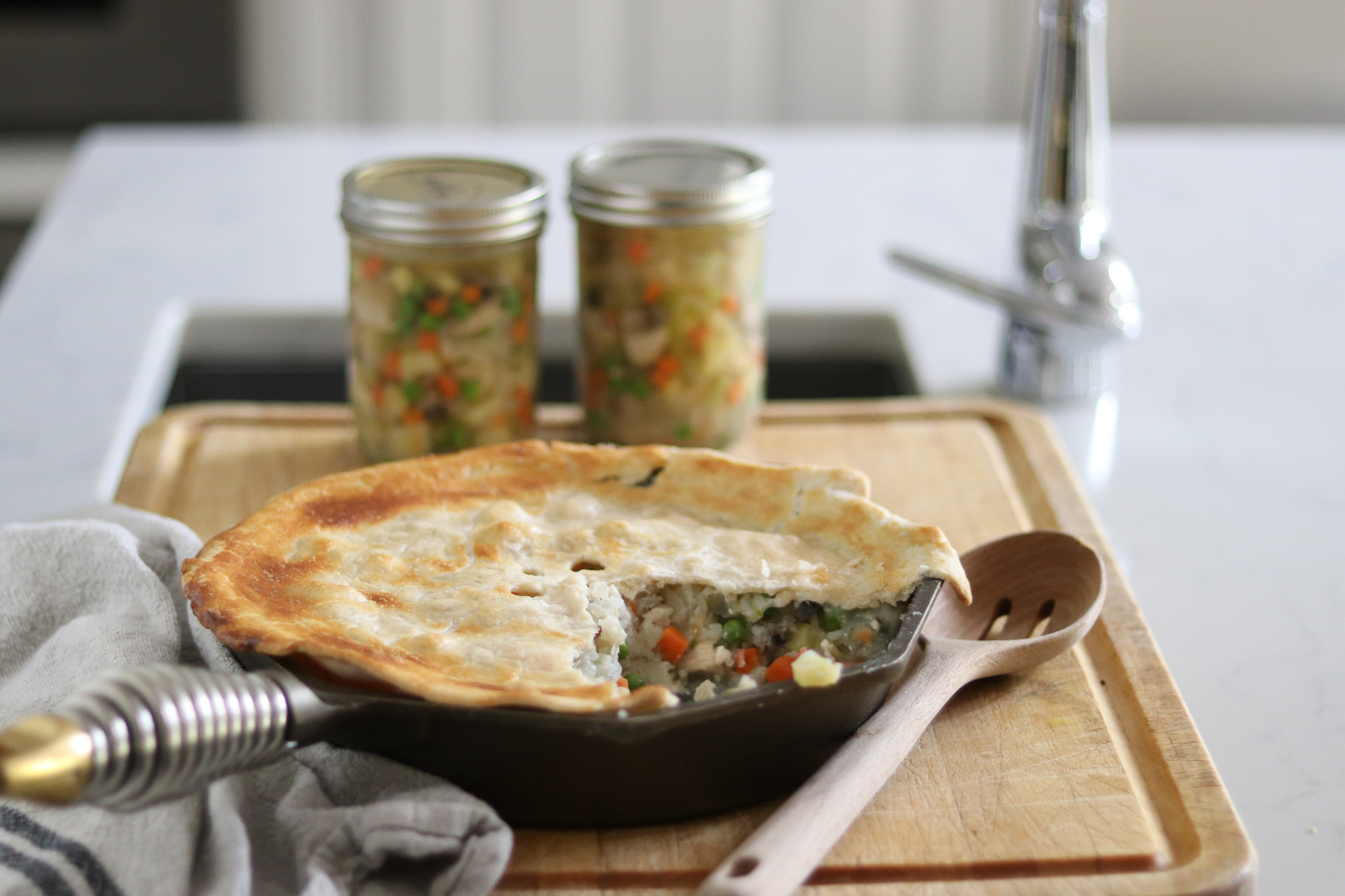
Cook this mixture, stirring regularly, until golden brown. Add the reserved broth, continuing to stir, until the mixture is smooth and thickened. Stir in the strained chicken mixture, then remove from the heat.
Place a pie crust on the bottom of the pan. Pour the filling on top, then add an additional pie crust. Tuck the edges under and crimp with a fork.
Cut slits in the top of the pie so steam can escape, then bake for 20 minutes at 400 degrees Fahrenheit (200 Celsius), or until the crust is golden and the filling is bubbly.
Enjoy!
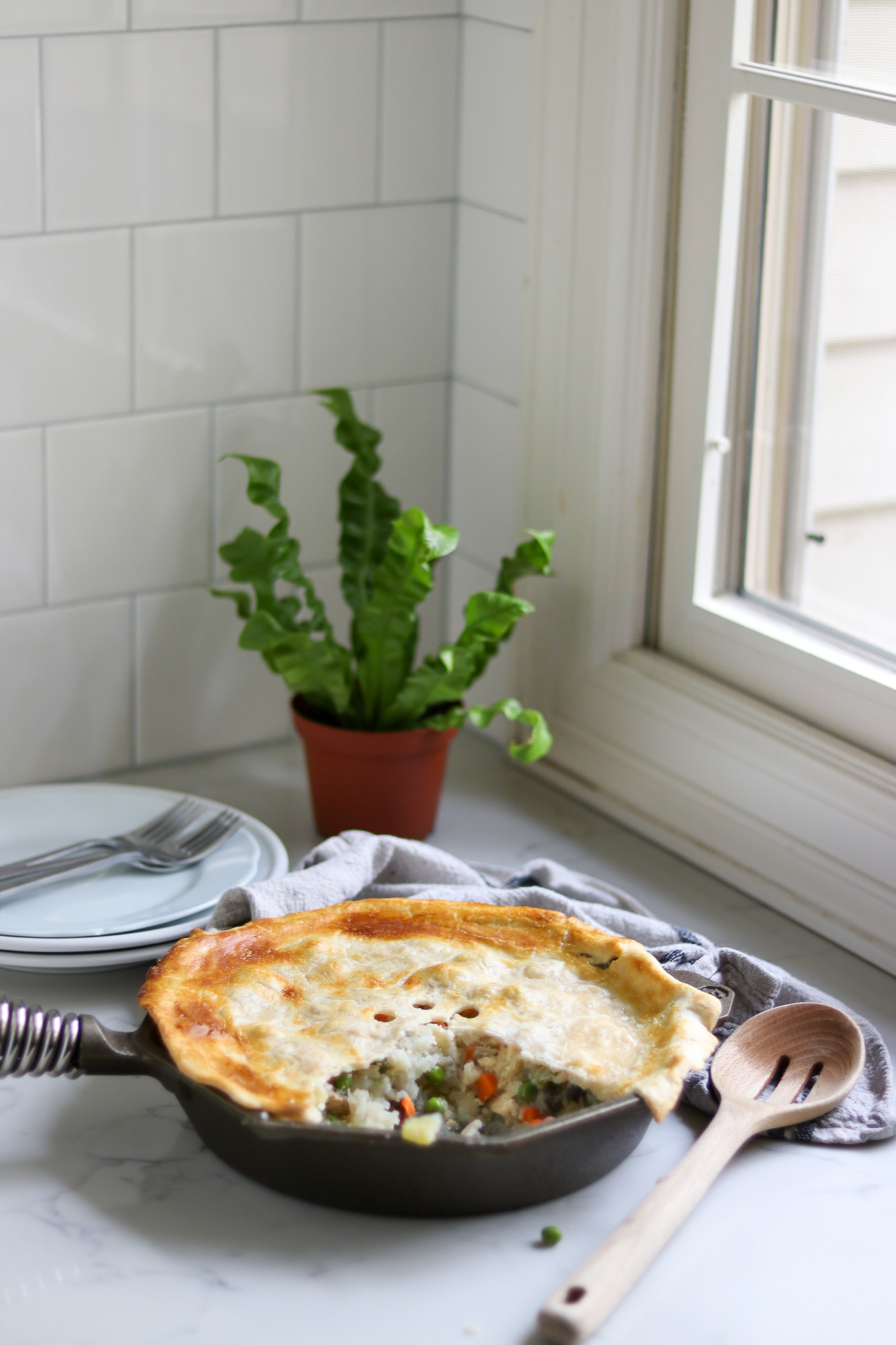
Chicken Canning Recipes
Looking for more chicken canning recipes?
- Canning Chicken Broth
- Canning Chicken
- Canning White Chicken Chili
- Canning Chicken Chili Verde
- Canning Chicken Soup
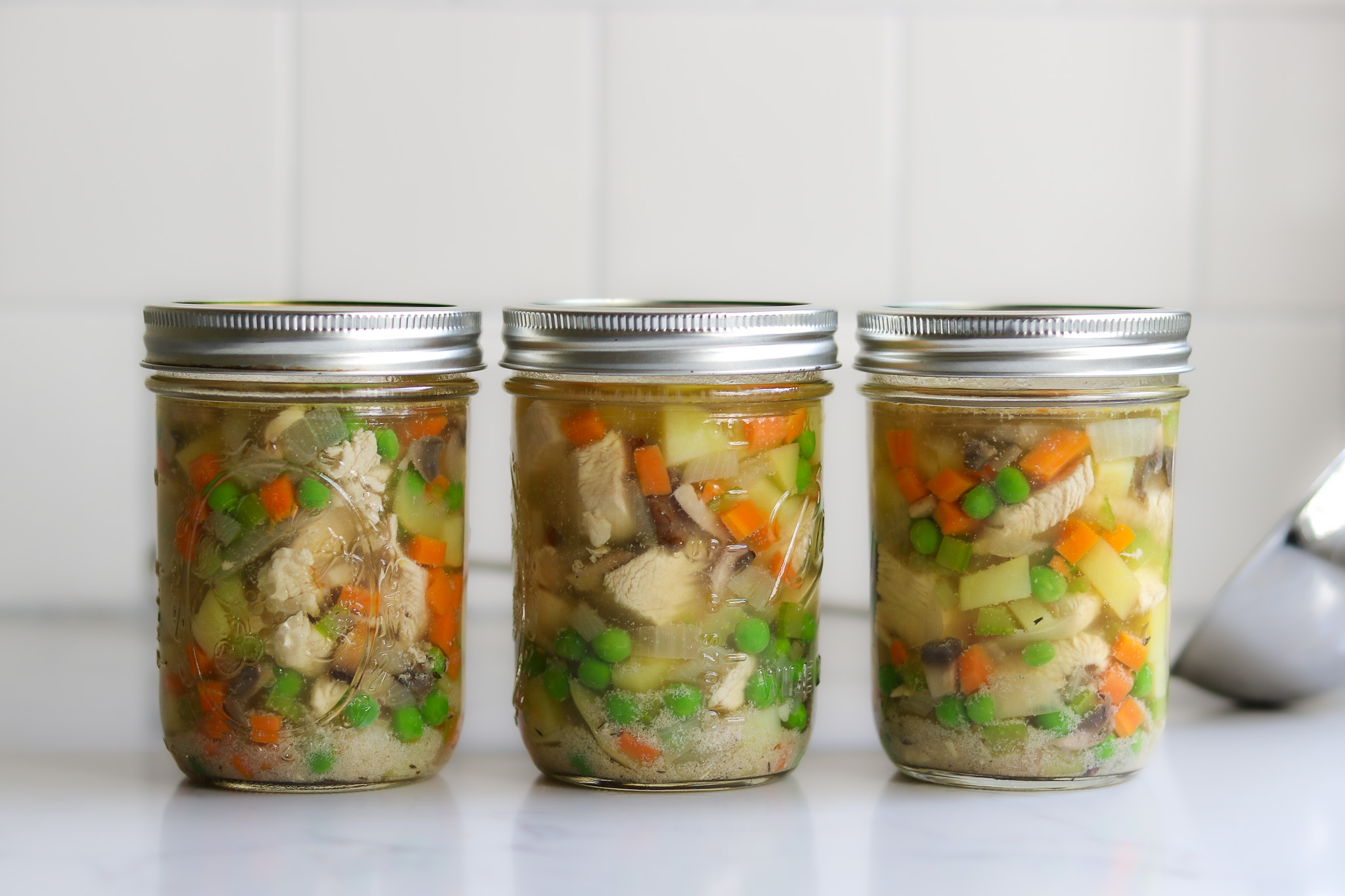
Meal in a Jar Canning Recipes
Need a few more meal-in-a-jar canning recipes?
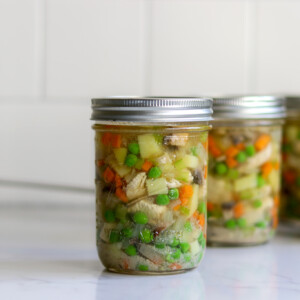
Canning Chicken Pot Pie Filling
Equipment
Ingredients
- 3 cups chicken, raw, skinned and boned, cut into 1-inch (2.5 cm) cubes
- 1 ½ cup onion, diced, about 2 medium onions
- ½ cup mushrooms, fresh, diced
- 1 ½ cup carrots, diced, roughly 3 medium carrots
- 1 cup Yukon gold potatoes, diced
- ½ cup peas, fresh or frozen
- ½ cup celery, diced
- 5 cups chicken stock, or bone broth
- 3 tbsp butter
- 1 cup dry white wine
- 1 tsp dried thyme
- 1 tsp salt
- ½ tsp black pepper
- 1 bay leaf
- 1 tbsp lemon juice, bottled or fresh, for flavor
Instructions
- Melt butter over medium heat. Add mushrooms and onions, then saute until the mushrooms are lightly browned (about three minutes).
- Add the chicken, carrots, potatoes, and celery, again, sauteeing until golden brown, or for about five minutes.
- Stir in the stock and then add the white wine, thyme, salt, pepper, and bay leaf.
- Bring to a boil, then reduce heat to medium and cook uncovered for about 10 minutes, or the vegetables are tender and the chicken is cooked through, stirring often.
- Once the chicken is cooked through, remove the bay leaf and take the pan off the heat, then stir in the peas and lemon juice.
- Ladle the mixture into hot jars, leaving 1" (2.5 centimeters) of headspace.
- Use the air bubble tool to remove any bubbles, then make sure adequate headspace remains. Wipe the rims of the jars to remove any food particles.
- Apply the bands and lids, then adjust to fingertip tight.
- Repeat until all jars are filled, then load each jar into your canner. Put the lid on the canner and turn to the locked position.
- Adjust the heat to medium-high and steam for 10 minutes.
- Put the counter weight or weight gauge on the vent (depending on manufacturer's instructions), then bring the pressure to 10 lbs for a weighted-gauge canner or 11 lbs pressure for a dial-gauge canner. (Be sure to adjust for altitude, see notes.)
- Process pint jars for 75 minutes, and quart jars for 90 minutes.
- Turn off the heat, then allow the canner to return on its own to zero pressure. Let the canner sit for five more minutes before removing the lid. Cool the jars in the canner for 10 minutes, then let them cool on the counter for 12 hours.
- Check the seals and store them for up to one year.
Notes
Altitude Adjustments for Canning Pot Pie Filling
Canning time remains the same regardless of altitude. However, the processing pressure increases as altitude increase. Use the following table to determine the correct processing pressure if you’re above 1,000 feet in elevation.For dial gauge pressure canners:
- 0 to 2,000 feet in elevation – 11 lbs pressure
- 2,001 to 4,000 feet in elevation – 12 lbs pressure
- 4,001 to 6,000 feet in elevation – 13 lbs pressure
- 6,001 to 8,000 feet in elevation – 14 lbs pressure
For weighted gauge pressure canners:
- 0 to 1,000 feet in elevation – 10 lbs pressure
- Above 1,000 feet – 15 lbs pressure
To Serve
To serve it as a soup, simply reheat it upon opening the jars, either on the stovetop or in the microwave. If you’d like to enjoy it as a chicken pot pie, preheat the oven to 400 degrees Fahrenheit (200 degrees Celsius). Strain the broth from the jars, reserving some of the broth off to the side. Melt two tablespoons of butter in a skillet over medium heat, stirring in two tablespoons (30 ml) of flour as a thickener. Cook this mixture, stirring regularly, until golden brown. Add the reserved broth, continuing to stir, until the mixture is smooth and thickened. Stir in the strained chicken mixture, then remove from the heat. Place a pie crust on the bottom of the pan. Pour the filling on top, then add an additional pie crust. Tuck the edges under and crimp with a fork. Cut slits in the top of the pie so steam can escape, then bake for 20 minutes at 400 degrees Fahrenheit (200 Celsius), or until the crust is golden and the filling is bubbly.Nutrition
Nutrition information is automatically calculated, so should only be used as an approximation.
Soup Canning Recipes
There are so many different soup canning recipes out there, try these for your pantry:
Pressure Canning Recipes
Fill your pressure canner again with these simple pressure canning recipes:

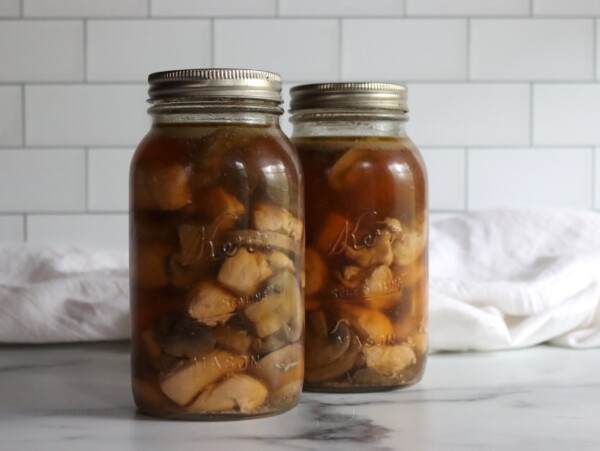
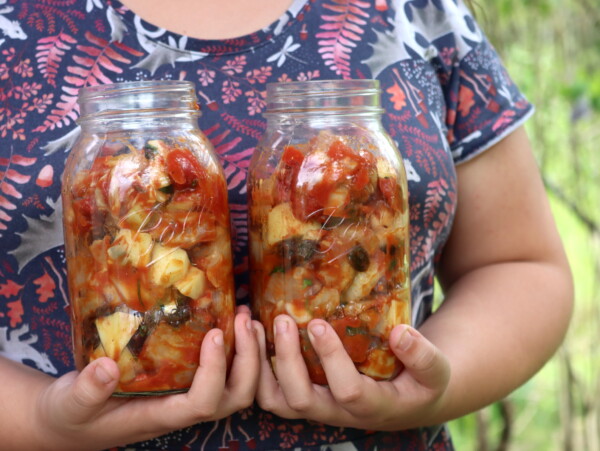
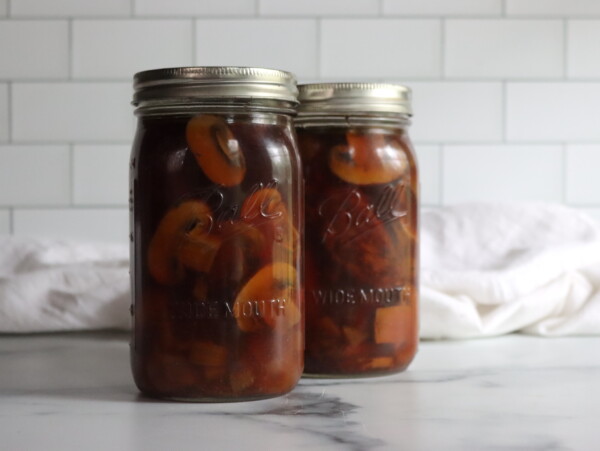
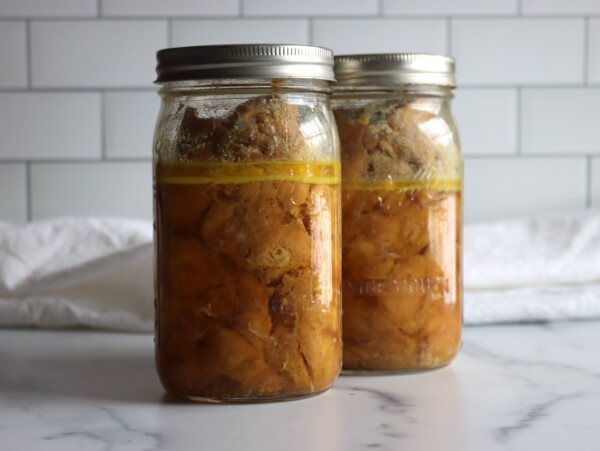
What is serving size in nutrition info ?
This recipe makes 6 pints and I’ve set it up as 12 servings, so each serving is 1 cup (or 1/2 pint). Enjoy!
Is it ok to leave out the chicken and add more veggies for a veggie pot pie?
Yes, that’s fine. Use the “hearty soups” protocol I outline here and you can adjust the recipe to your tastes without meat: https://creativecanning.com/choice-soup-canning-recipe/
Do you need to use dry white wine in this recipe? If so, is there a substitute I can use?
Thank you!
That’s for flavor, not for preservation. If you’d like, a splash of cider vinegar or white wine vinegar will give you the same acidity to brighten the flavor, but that’s optional. You can just use an extra cup of chicken broth and skip the wine. Enjoy!
If you want the flavour of wine but not the alcohol I have used 0% alcohol savignon blanc wine from my grocery store in other recipes with good results.
That sounds fabulous!
Amazing recipe 🙏🏻 so delicious thank you
You’re quite welcome!
Pressure canned this and made 4 quarts and 1 pot pie for testing and it was delicious 😋. My first meat canning experience so thank you 🙏🏻 Hubby gave it 👍
Wonderful, so glad you enjoyed it!
Thank you for sharing all of these fabulous recipes. May I please ask how many pints of pot pie filling you use to make one deep dish pot pie please?
I’ve found that with my pie pan, I want 1 quart and 1 pint for a regular tin, but then I have a really deep pie pan that I use 2 quarts with. It kind of depends on how much filling you want in the pie, and my husband actually likes it with less filling and more crust (so 1 quart per regular pie crust).
Hi Ashley. Do you have any insight on replacing onion with other vegetables? As I understand, generally you can replace veggies with a similar type but there just isn’t much similar to onion 😬. I always add more garlic in recipes but can’t add 1.5 cups of garlic LOL! I have an onion allergy and canning recipes are so difficult because onion is generally a bulky part of the recipe and I prefer heartier recipes over brothier recipes. Thanks!
The onion in this recipe actually really shrinks and it doesn’t bulk out the soup. I think it’s perfectly fine to just leave it out. Some sources say that you can substitute bell peppers in place of onions, and others say you cant. Personally, if I needed to avoid onions I’d just omit them and fill the jars without them (and get a slightly lower yield, rather than making up the space with broth).
I noticed you sautéed the vegetables in butter, but I didn’t think you could use dairy products in canning. Can you advise me further? Thank you!
While you can’t can butter in jars as a single ingredient, you can use butter and oils in the process of canning other things. Sauteeing veggies in butter is fine for canning (as is adding a small amount of butter to water bath canning jams/jellies to reduce foaming). If you’d rather skip it, you can use another oil (animal or vegetable) in it’s place, anything from lard to olive oil.
This sounds really good. I am going to quadruple the recipe. Just wondering if it would be okay to use a different kind of potato instead of the Yukon Gold. Thanks for your help.
Yup, you can use any type of white/yellow/red potato. (Just no sweet potatoes.)
I get so many ideas from you, canning chicken pot pie mix, perfect. I already make chicken pot pie but never thought about canning it. I pressure cook the chicken first, then cut up and add cooked chicken and now I also have soup stock but I still add some chicken bouillon. Also use garlic in mine. Thanks for all the great ideas.
Nice, that sounds delicious. You can definitely add garlic to this recipe too. Enjoy!
I’m just a few recipes into learning to pressure can. Is the lemon juice in this recipe to lift the flavor of the finished product, or is it needed for the acid content? I’m allergic to lemon, so wondering if it can be left out. If needed for the acid I can replace with lime.
The lemon in this recipe is for flavor, and not required at all for preservation. You can use a cup of white wine, or a few tablespoons of white wine vinegar instead (or just skip it). Enjoy!
One pint makes one family sized pot pie? I am wondering because the beef pot pie recipe is one quart for one pie. Just trying to figure out if this is 6 meals or 3. Thanks!
You’ll need about a quart for a normal pie pan with this filling.
Since I don’t usually have fresh peas, should I can this with frozen or wait to add them when I prepare the pie?
Frozen peas work wonderfully in this recipe.
Do I still use 10 lbs pressure above 1,000 elevation? Many other recipes use 15. Thanks!
Great question! Yes, you do need to adjust for altitude. I’ve added the altitude adjusments to the recipe, but here they are:
Altitude Adjustments for Canning Pot Pie Filling
Canning time remains the same regardless of altitude. However, the processing pressure increases as altitude increase.
Use the following table to determine the correct processing pressure if you’re above 1,000 feet in elevation.
For dial gauge pressure canners:
0 to 2,000 feet in elevation – 11 lbs pressure
2,001 to 4,000 feet in elevation – 12 lbs pressure
4,001 to 6,000 feet in elevation – 13 lbs pressure
6,001 to 8,000 feet in elevation – 14 lbs pressure
For weighted gauge pressure canners:
0 to 1,000 feet in elevation – 10 lbs pressure
Above 1,000 feet – 15 lbs pressure
Forgive me if you wrote it but I don’t see it: how many quarts/pints does this recipe make? Thank you!
So sorry! I just found it: 6 pints.
Wonderful, glad you found it!
It makes 6 pints or 3 quarts.
The timing for canning quarts is 1 hour 30 minutes (or 90 minutes.) Is that correct Ashley?
Great question! Yes, the time for quarts is 90 minutes. I’ve added that to the recipe.
Why didn’t you put the recipe for water canning a long with the one for pressure canning?
The last time “water bath canning for a long time” was considered safe was nearly 100 years ago, and it’s since been shown to be undependable. Sometimes it’ll sterilize sufficiently, but not always, and the consequences there can be deadly if you’re not lucky. I don’t include water bath canning recipes for meat on my site.
Water Bath Canning has always been SAFE — Do you know that there are countries that BAN – PRESSURE CANNING as unsafe!
What countries ban pressure canning?!?!? I’m not sure I’ve ever seen any law on the books anywhere about that.